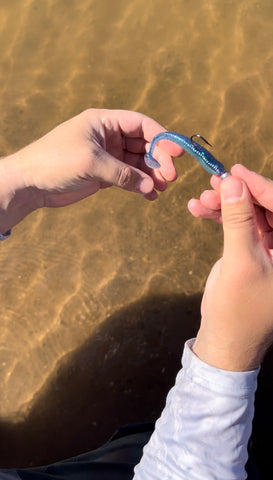Mastering the Art of Rigging Paddle Tails: A Step-by-Step Guide

Paddle tail soft plastics are a favorite among anglers due to their versatile and lifelike swimming action. Whether you're targeting freshwater bass or saltwater species, knowing how to rig a paddle tail properly can significantly enhance your fishing experience. In this article, we'll explore various methods to rig paddle tails, ensuring you get the most out of these fantastic lures.
1. Jig Head Rigging
One of the most common and effective ways to rig paddle tails is on a jig head.
- Step 1: Choose a jig head with a hook size that matches the size of your paddle tail.
- Step 2: Insert the hook point into the head of the paddle tail, ensuring it's centered.
- Step 3: Push the hook through the body, making sure it emerges along the back, keeping the bait straight.
- Step 4: Slide the paddle tail up the hook shank until it sits snugly against the jig head.
2. Texas Rigging
For fishing in areas with heavy cover or vegetation, the Texas rig is ideal as it's weedless.
- Step 1: Use a worm hook or an offset shank hook.
- Step 2: Insert the hook point into the top of the paddle tail about a quarter of an inch.
- Step 3: Push the hook out the side, then slide the paddle tail up the hook shank until it reaches the offset.
- Step 4: Rotate the bait, positioning the hook point so it lays flat against the body. For a weedless presentation, bury the hook point slightly into the body of the paddle tail.
3. Weighted Swim Bait Hook
This method gives the paddle tail a more natural, free-swimming action.
- Step 1: Choose a weighted swimbait hook that matches your paddle tail size.
- Step 2: Rig the paddle tail in a similar manner to the Texas rig, ensuring the weight is at the bottom, giving the bait a natural swimming motion.
4. Carolina Rigging
The Carolina rig allows the paddle tail to cover deeper water columns.
- Step 1: Slide a bullet weight onto your main line, followed by a bead.
- Step 2: Tie a swivel to the main line.
- Step 3: Attach a leader (1 to 3 feet) to the other end of the swivel.
- Step 4: Rig the paddle tail onto a hook at the end of the leader using the Texas rig method.
5. Drop Shot Rigging
For a finesse approach, especially in pressured waters, the drop shot rig is effective.
- Step 1: Tie a hook onto your main line using a Palomar knot, leaving a long tag end.
- Step 2: Attach a drop shot weight to the tag end.
- Step 3: Rig the paddle tail onto the hook, ensuring it's nose-hooked so it can move freely.
Tips for Rigging Paddle Tails:
- Stay Straight: Ensure the paddle tail is rigged straight. A crooked bait will not swim correctly and may spin in the water.
- Match the Hatch: Choose a paddle tail size for the correct target of fish and color that mimics the natural prey in the waters you're fishing is important and can increase chances of catching more and bigger fish.
- Experiment: Different rigging methods can produce varying actions. Don't hesitate to switch things up based on the conditions and fish behavior.
If your looking for paddle tails to catch your next personal best, then check out our bass slayer paddle tails, we have a wide variety of sizes and colors. Also, use code nicecatch at checkout for 25% off your order.
Conclusion
Paddle tails are a versatile lure that can be rigged in multiple ways to suit various fishing conditions. By mastering these rigging techniques, you'll be well-equipped to adapt to any situation on the water and increase your chances of landing that prized catch. Happy fishing!




